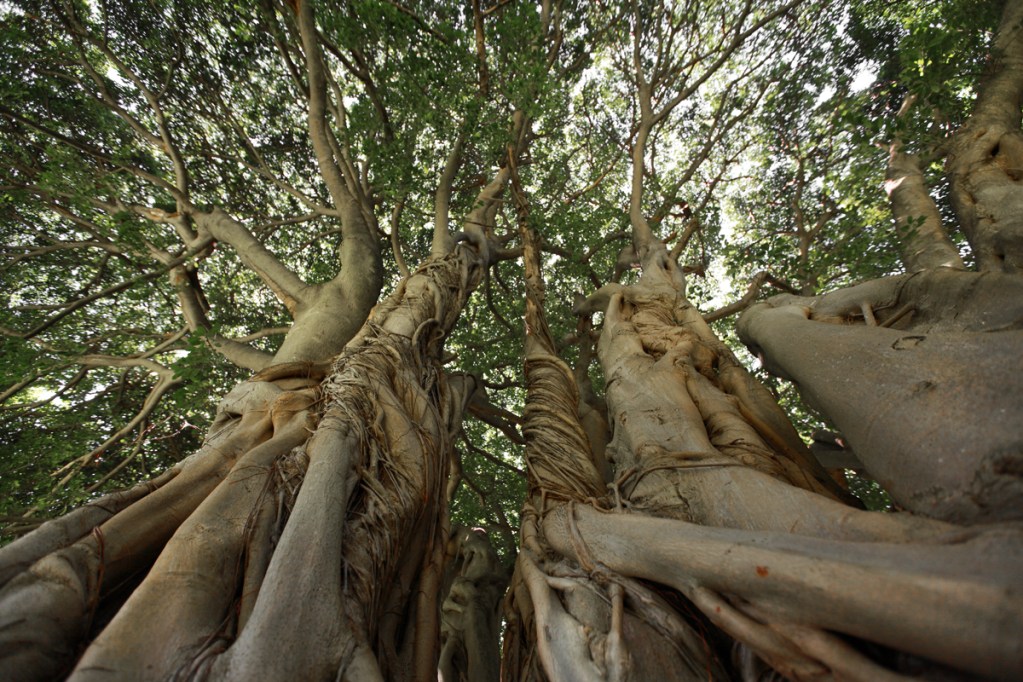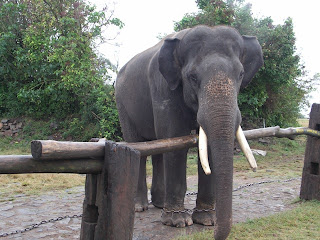Introduction: Literary classics abound in all languages of the word and it is indeed a pleasure to read them and appreciate how our ancestors viewed life and how every civilization differed from each other in viewing at the aims and pursuits of life in this world. The objective here is to present once a week, the best poem or sloka or verse or song I have read among the different literary works of the world. "யான் பெற்ற இன்பம் பெருக இவ்வையகம்" என்று திருமூலர் திருமந்திரத்தில் கூறியதுபோல, let everyone attain the bliss I have received in reading them.
ஐங்குறுநூறு (Literally meaning: Five short hundred) பேயரில் உள்ளதுபோல 500 குறுகிய பாடல்களைக்கொண்டது. இதிலுள்ள சில பாடல்கள் குறுந்தொகையவிட சிறியது; அதாவது, 3 முதல் 6 வரிகள் வரை உடையது. For me, Ainkurunooru is perhaps the most systematically organized Sangam anthology, as it contains 100 poems each on the five Tinais (ஐந்தினை). And each of these 100 is sung by a particular poet. அதாவது,
1. மருதம் by ஓரம்போகியார்
2. நெய்தல் by அம்மூவனார்
3. குறிஞ்சி by கபிலர்
4. பாலை by ஓதலாந்தையார்
5. முல்லை by பேயனார்.
The work’s amazing organization does not end here. Each of these 100 poems is grouped into 10 sections and each section contains 10 stanzas. இப்படி ஒழுங்காக தொகுத்து வழங்கிய பெருமை கூடலூர் கிழார் என்ற ஒரு புலவரைச்சாரும். The titles given to these chapters of 10 poems are based on the frequent occurrence of a word or phrase in each of these 10 poems. Interestingly many of these chapter names are those of animals and plants. Some of these are….
- Crab ten (களவன் பத்து)
- Buffalo ten (எருமைப் பத்து)
- Cassia ten (ஞாழற் பத்து)
- Little egret ten (வெள்ளாங் குருகுப் பத்து)
- Terns ten (சிறுவெண் காக்கைப் பத்து.)
- Wild boars ten (கேழற் பத்து)
- Monkey ten (குரக்குப் பத்து)
- Parakeets ten (கிள்ளைப் பத்து)
- Peafowls ten (மஞ்சைப் பத்து)
To the best of my knowledge, the work has been translated into English at least twice. Once by P. Jotimuthu in 1984 published by the Madras Christian Literature Society (this may well be out of print) and recently in 2011 by Martha Ann Selby as a publication of Columbia University Press.
இனி ஐங்குறுநூற்றிலுள்ள பாடல்களுக்கு வருவோம். அருமையான பல பாடல்கள் இதில் உள்ளன. எதை எடுத்தொச்சொல்வதென்று எனக்குத் தெரியவில்லை. After a long consideration, I have decided to highlight the following poems:
1) Crabs and crocodiles (Poet: Orampokiyar / ஓரம்போகியார்)
 |
| Freshwater crocodile (C. palustris) |
தாய்சாப் பிறக்கும் புள்ளிக் கள்வனொடு
பிள்ளை தின்னும் முதலைத்து அவனூர்
எய்தினன் ஆகின்று கொல்லோ? மகிழ்நன்
பிள்ளை தின்னும் முதலைத்து அவனூர்
எய்தினன் ஆகின்று கொல்லோ? மகிழ்நன்
பொலந்தொடி தெளிர்ப்ப முயங்கியவர்
நலங்கொண்டு துறப்பது எவன்கொல்? அன்னாய் !
நலங்கொண்டு துறப்பது எவன்கொல்? அன்னாய் !
Has he really gone back to his own city,
Where about spotted crabs at whose birth their mother dies;
And where crocodiles swallow their own brood?
How can he, after love’s embrace to the tinkling of my golden bracelets,
Having robbed me of my maiden loveliness, desert me now?
(Ainkurunuru, 24) [Translator: P.N. Appuswami]
2) Reed flowers and manes (Poet: Orampokiyar / ஓரம்போகியார்)
 |
| Inflorescence of Saccharum spp. (Photo: Dawn Smith) |

The word vezham (வேழம்) in ancient Tamil literature had three major meanings: (i) Bull elephant (e.g. Naladiyar, 358; Purananuru, 152), (ii) sugarcane (Natrinai, 241; Akananuru, 6), (ii) bamboo (Akananuru 309) and (iii) a kind of reed or tall grass (Ainkurunuru, 13) (Subramanian, 1990). However, it is invariably used to refer the elephant and poem 13 in Ainkurunuru is one of the rare occasions where this word clearly means a tall grass.
Here poet Orampokiyar compares the inflorescence of the tall grass to the manes of horses. Identified as plume grass (Saccharum arundinaceum) by Krishnamurthy (2007), vezham (வேழம்) is related to sugarcane (S. officinarum). Since sugarcane finds a mention in almost all ancient literary works of Tamils, the cultivated plant appears to have originated in India (Mukherjee, 1957; Krishnamurthy, 2007). Since it is closely related to all members of the genus Saccharum, it is only natural that Tamil poets have sometimes used the same word vezham to mean the cultivated sugarcane as well.
Here poet Orampokiyar compares the inflorescence of the tall grass to the manes of horses. Identified as plume grass (Saccharum arundinaceum) by Krishnamurthy (2007), vezham (வேழம்) is related to sugarcane (S. officinarum). Since sugarcane finds a mention in almost all ancient literary works of Tamils, the cultivated plant appears to have originated in India (Mukherjee, 1957; Krishnamurthy, 2007). Since it is closely related to all members of the genus Saccharum, it is only natural that Tamil poets have sometimes used the same word vezham to mean the cultivated sugarcane as well.
பரியுடை நன்மான் பொங்குளை யன்ன
வடகரை வேழம் வெண்பூப் பகரும்
தண்துறை யூரண் பெண்டிர்
துஞ்சூர் யாமத்துந் துயலறி யலரே.
He is the lord of the land of many cool and lovely fountains,
Where reeds by the sea-shore parade their white flowers
Shining and glistening like the bristling manes of noble prancing steeds;
But alas! Those who love him know no sleep
Even in the middle of the night when the whole city sleeps.
(Ainkurunuru, 13) [Translator: P.N. Appuswami]
Nāladiyār (நாலடியார்), a didactic in Tamil belonging to circa 7th century A.D., also has a poem where the flower of sugarcane (S. officinarum) is compared to the mane (தீம் கரும்பு ஈன்ற திரள் கால் உளை அலரி: Poem 199). Since only the mane is mentioned and not the animal, translators have interpreted it to mean it either as the horse or lion.
The reason why I have chosen the following poem is because of the reference to a species of fig.
கல் இவர் இற்றி புல்லுவன எறிக்
குளவி மேய்ந்த மந்தி துணையோடு
வரைமிசை உகளும் நாட நீவரின்
கல்லகத் ததுஎம் ஊரே
அம்பல் சேரி அலராம் கட்டே.
Man from the mountain country where female
monkeys leap around with their mates
on white fig trees that spread
their roots tightly on boulders
eating tender kulavi leaves nearby,
if you come to our town
surrounded by mountains,
there will be rumour and slander in our settlement.
monkeys leap around with their mates
on white fig trees that spread
their roots tightly on boulders
eating tender kulavi leaves nearby,
if you come to our town
surrounded by mountains,
there will be rumour and slander in our settlement.
(Ainkurunuru 279) [Translator: Vaidehi]
 |
| Ficu drupacea (left) and Ficus talboti (right) |
The word குளவி here refers to jungle or forest jasmine (Jasminum spp.). And of course there are monkeys on them, surprisingly not feeding the fig fruits but on the tender leaves of kulavi which is apparently a species of jungle jasmine! It is very likely that the fig tree in question was not in the fruiting stage for otherwise the monkeys would have preferred them over leaves. The manthi (மந்தி) or monkey here could be the folivorous gray langur (Semnopithecus spp.) and not bonnet macaque (Macaca radiata).
References:
1) Krishnamurthy, K.V. 2007. தமிழரும் தாவரமும். பாரதிதாசன் பழ்கலைக்கழகம், திருச்சிராப்பள்ளி. Page 406
2) Mukherjee, S.K. 1957. Origin and Distribution of Saccharum. Botanical Gazette
2) Mukherjee, S.K. 1957. Origin and Distribution of Saccharum. Botanical Gazette
Vol. 119, No. 1: 55-61
3) Subramanian, N. 1990. Pre-Pallavan Tamil Index. University of Madras. Page798
3) Subramanian, N. 1990. Pre-Pallavan Tamil Index. University of Madras. Page798
===================================================================
I Home I Claims & Criticisms I Purpose of this site I What is new here? I Forthcoming topics I
I Comparative Religion I Gospel of Vivekananda I
I Kural in 30 languages I Mathematical mircale in Kural I Introduction to the Kural I Kural and Worldly Wisdom I
I Comparative Religion I Gospel of Vivekananda I
I Kural in 30 languages I Mathematical mircale in Kural I Introduction to the Kural I Kural and Worldly Wisdom I
===================================================================



